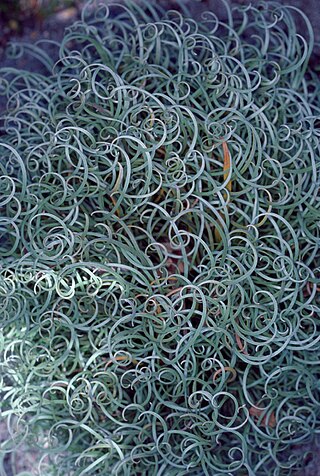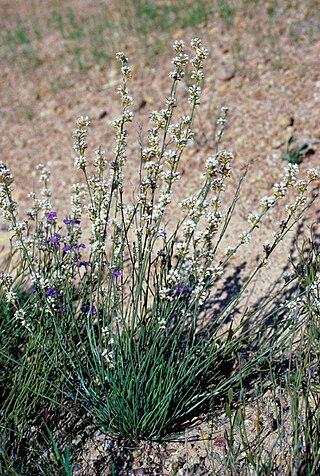
Conospermum glumaceum, commonly known as hooded smokebush, is a species of flowering plant in the family Proteaceae and is endemic to the south-west of Western Australia. It is an erect shrub with more or less clustered, linear leaves, and panicles of dense, head-like spikes of tube-shaped, cream-coloured flowers and white to golden nuts.

Conospermum longifolium, commonly known as the long leaf smokebush, is a species of flowering plant of the family Proteaceae and is endemic to New South Wales. It is a dense shrub or undershrub with linear to narrowly lance-shaped leaves, panicles of white flowers and velvety, cream-coloured to dark brown nuts.

Conospermum mitchellii, commonly known as Victorian smokebush, is a species of flowering plant of the family Proteaceae and is endemic to the western half of Victoria. It is an erect shrub with crowded, linear leaves, panicles of white, blue or lilac flowers and orange or reddish brown nuts.

Conospermum ellipticum is a species of flowering plant in family Proteaceae and is endemic to New South Wales. It is an erect shrub with hairy, elliptic leaves, panicles of cream-coloured to white flowers and golden, hairy nuts.

Conospermum bracteosum is a species of flowering plant in the family Proteaceae and is endemic to the south-west of Western Australia. It is an erect, spindly shrub with egg-shaped leaves, sometimes with the narrower end towards the base, and spikes of silky, woolly, tube-shaped white flowers.

Conospermum capitatum is a species of flowering plant in the family Proteaceae, and is endemic to the south-west of Western Australia. It is a low, erect shrub with coiled leaves and head-like panicles of red to pale yellow and hairy, tube-shaped flowers.

Conospermum croniniae is a species of flowering plant in the family Proteaceae and is endemic to the south-west of Western Australia. It is an erect, open shrub with spreading cylindrical leaves and spikes of up to 6 pale blue or pink, tube-shaped, hairy flowers.

Conospermum densiflorum, commonly known as crown smokebush, is a species of flowering plant in the family Proteaceae and is endemic to the south-west of Western Australia. It is an erect, much-branched shrub with thread-like leaves at the base of the plant, and spikes or corymbs of velvety, cream-coloured or blue, tube-shaped flowers.

Conospermum eatoniae, commonly known as blue lace, is a species of flowering plant in the family Proteaceae and is endemic to the south-west of Western Australia. It is a spreading shrub with egg-shaped leaves only present on young plants, and panicles of glabrous blue, tube-shaped flowers with pale green bracteoles.

Conospermum ephedroides is a species of flowering plant in the family Proteaceae and is endemic to the south-west of Western Australia. It is a tufted shrub with many stems, a few cylindrical leaves at the base of the plant, and sessile spikes of glabrous white, pale pink or blue, tube-shaped flowers and reddish-brown to orange nuts.

Conospermum flexuosum, commonly known as the tangled smokebush, is a species of flowering plant in the family Proteaceae and is endemic to the south-west of Western Australia. It is a sprawling shrub with many zig-zag branches, panicles of white to pale blue, tube-shaped flowers and urn-shaped, hairy nuts.
Conospermum microflorum is a species of flowering plant of the family Proteaceae and is endemic to Western Australia. It is a rounded shrub with glabrous, thread-like leaves, panicles of woolly hairy, white or cream coloured flowers and woolly hairy, orange-brown nuts.
Conospermum paniculatum is a species of flowering plant in the family Proteaceae and is endemic to the south-west of Western Australia. It is an erect, much-branched shrub with spoon shaped to egg-shaped leaves with the narrower end towards the base, and spikes of blue to pink, tube-shaped flowers, the fruit an urn-shaped nut.
Conospermum petiolare is a species of flowering plant in the family Proteaceae and is endemic to the south of Western Australia. It is a tufted subshrub or shrub with dense, erect, narrowly oblong leaves, and panicles of velvety cream-coloured, orange-yellow or pink, tube-shaped flowers, the fruit a hairy, brownish-yellow to gold-coloured nut.

Conospermum scaposum is a species of flowering plant in the family Proteaceae and is endemic to the south-west of Western Australia. It is a low, erect shrub with linear leaves and dense spikes of blue, tube-shaped flowers covered with long, silky hairs.
Conospermum sigmoideum is a species of flowering plant in the family Proteaceae and is endemic to the south of Western Australia. It is an erect shrub with S-shaped leaves, circular in cross section, and spikes of 5 to 10, pale blue, tube-shaped flowers with deep blue bracteoles.

Conospermum spectabile is a species of flowering plant in the family Proteaceae and is endemic to the south-west of Western Australia. It is an erect, compact shrub with S-shaped leaves that are circular in cross section, and panicles of woolly white and blue, tube-shaped flowers.

Conospermum hookeri, commonly known as Tasmanian smokebush, is a species of flowering plant in the family Proteaceae and is endemic to Tasmania. It is a shrub with many branches, spatula-shaped or linear leaves, panicles of spikes of white, tube-shaped flowers and reddish brown nuts covered with silky fawn-coloured hairs.

Conospermum burgessiorum is a species of flowering plant in family Proteaceae and is endemic to eastern Australia. It is an erect to spreading shrub with linear leaves, panicles of cream-coloured to white flowers and reddish brown nuts.

Conospermum patens, commonly known as the slender smokebush, is a species of flowering plant of the family Proteaceae and is endemic to south-eastern continental Australia. It is an erect shrub with crowded linear or spatula-shaped leaves, panicles of densely hairy white, bluish-grey or purplish flowers and hairy, yellowish-brown nuts.

















